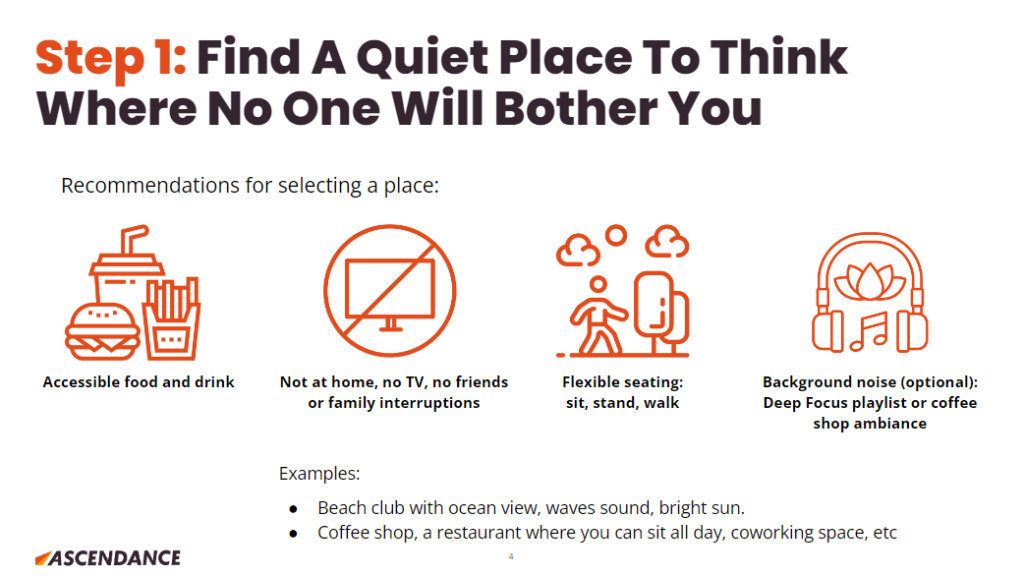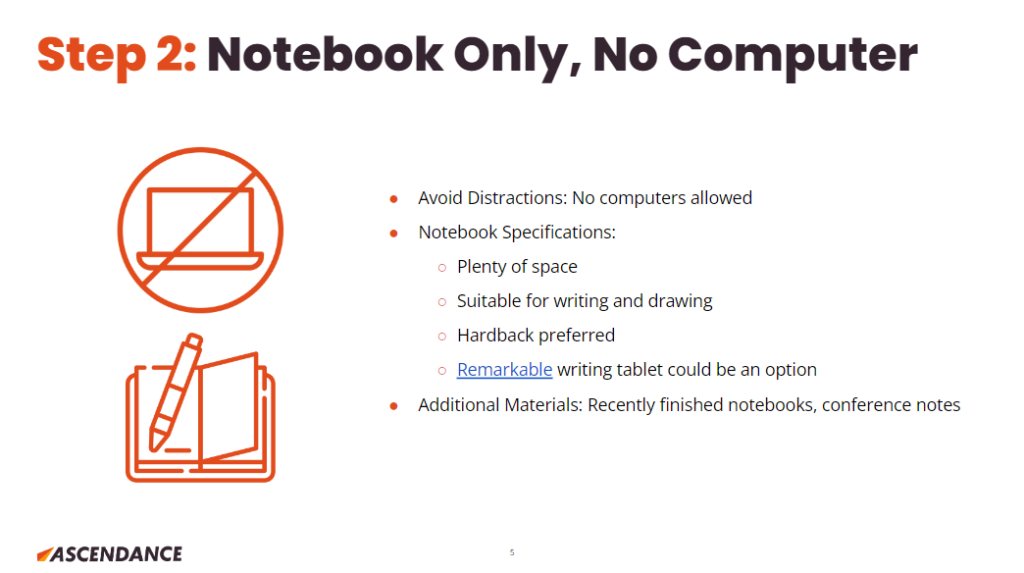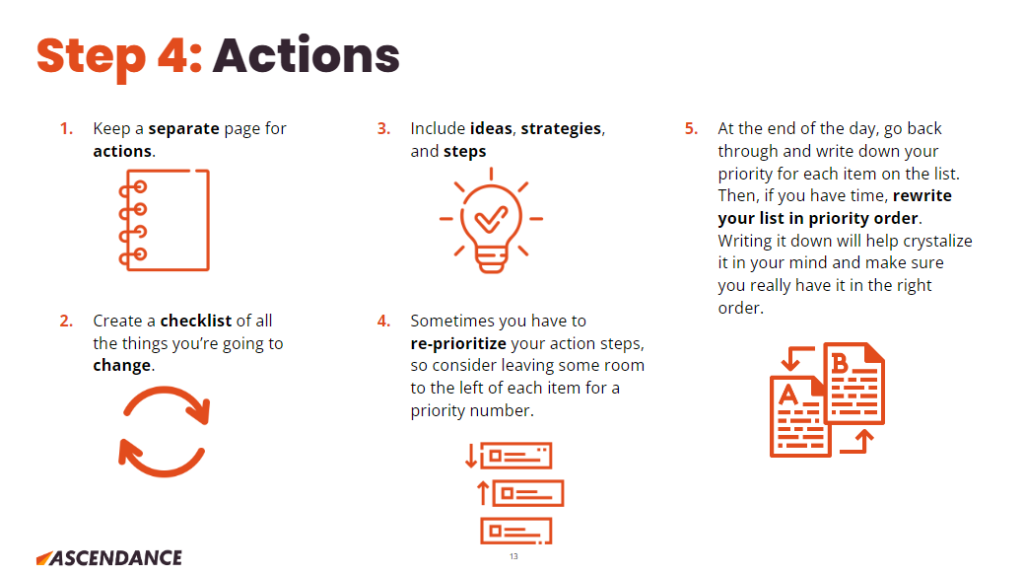Hola from Playa Del Carmen, Mexico! 🌮🌮🌮
I’ve been promising a blog with all of my resources on a regular basis for almost 2 years now – and I am FINALLY ready to start.
That said, I will be sending out (semi-)regular emails about business building, and new resources my team and I create on things like:
- Hiring
- Team performance management
- Forecasting
- OKRs & Accountability
- Management systems
- Leadership
- Interviews with entrepreneurs
- Powerpoints, spreadsheets, and videos I think you’ll find helpful in growing your businesses
- Notifications about free training webinars (more at the bottom of this email – The Forecasting Webinar is next week, June 20th at 10am EST)
You can get these business-building insights direct to your inbox by entering your email below ⬇️
To kick things off, one of the things I think entrepreneurs and executives have the hardest time doing is stopping.
I recently received a request to help out an entrepreneur on what I call Thinking Day. We talked about how she needed to stop working for a day and think about her business, but she didn’t know what to think about.
So I put together the ‘Thinking Day Directive’. I hope it’s helpful for you as well!
📆 Your Day Off Of Doing & Your Day On Of Thinking
The Thinking Day Directive is built to help you consider what you will be thinking about during your Thinking Day.
For many business owners, this is the most transformative day of their business. Taking a day to let your mind find solutions instead of just ‘doing’ all the time can accelerate your growth and help you find the shortcuts to success. One of my friends, Coran Woodmass recommended this to me years ago and every time I do it, I have eureka moments about my businesses. I find connections I hadn’t considered before, and easier steps to getting to where I want to go. Sometimes, after a day of thought, I will scrap an initiative, make a personnel change, or even open a new business or close an old one.
The goal of Thinking Day is to think deeply and undisturbed about your business to create a set of new strategies and actions you can take to improve the day-to-day and future of your business and life. It’s a way to let your mind run wild with ideas and let yourself consider things you haven’t considered before or in a long time.
The first important pre-requisite to Thinking Day is that you must be somewhat relaxed and ready to think. You can’t be overwhelmed, overtired, overworked, or anything else that makes you unable to think. This is a day to get clarity on your business, not catch up on rest. If you’re overtired or overwhelmed, take a day off or a week off then get back to a thinking day. This is a work day, just not a day of doing work, and you need to be ready for it.
The directive will take you through a series of things to consider during your Thinking Day.
🏖️ Step 1: Find A Quiet Place To Think Where No One Will
Bother You

My recommendations for selecting a place include being in a place where the following things are true:
- Food and drink are easily accessible and you don’t have to move or more than a few minutes to get this, and if you’re a coffee or tea drinker, coffee or tea is also easily available.
- The place is not your home and you’re not tempted to, or even can, turn on the television, lay in a bed, talk to friends, etc.
- Neither family nor friends will interrupt you.
- You can sit, stand, walk around, or sometimes lie down (but not fall asleep) for a period of time.
- I like to have a little background noise, either the Deep Focus playlist on Spotify or coffeeshop style background noise where there are people talking in the background, but I can’t hear or understand them.
- I live by the beach, so I like to go to a beach club (Serenity is my favorite) where I can see the ocean, listen to the waves, have food and drink brought to me, and the sun is bright which keeps me awake even with glasses on.
📓 Step 2: Notebook Only, No Computer
It’s easy to get sucked into ‘doing’ while you’re thinking. Entrepreneurs and executives often get started or halfway through their thinking day only to realize they’ve started doing and stopped thinking. So there are no computers allowed. You can bring your smartphone to look things up if you absolutely need to, but that’s as far as it goes.

Your notebook needs to have plenty of empty, available space to write, be big enough to draw pictures and flow charts, and I personally like to use lined paper with lines light enough to draw pictures over without issue. Also, I recommend having a hardback notebook instead of a paperback notebook because if you’re walking around or on an uneven surface, you can still write. Finally, I have friends who swear by the Remarkable writing tablet. That kind of device is certainly permissible.
IMPORTANT: If you recently finished up a notebook bring the finished one with you as well. If everything you do is digital, make sure that your notes to yourself are available on your mobile device for review. Finally, I often have separate notebooks for conferences and if I had a lot of lessons from a particular conference, I will bring that notebook as well. My favorite are my DCBKK and DCMEX conference notebooks.
🤔 Step 3: What To Think About
“What should I think about?” This is the question I get asked the most when I recommend people do this exercise so I put together the following set of ideas to consider.

What you’re going to want to think about depends on where you are in your business and what problems you’re facing at the moment. Here are a few things to consider first, and then how to think about those problems.
What you’ve learned recently 🧠
The first thing I normally do is open up my current or recently finished notebook as well as any learnings from past conferences (see my note on conference notebooks above) and flip through those pages to remind myself of what I was going to do and either never had time for or just didn’t do for whatever reason.
Often I learn from other entrepreneurs at conferences and make notes about how to improve my businesses from those conversations, then go on to make some changes and forget about others, so going back to review can be very helpful.
So go back through your recent notes, conversations, notebooks, and anything else that you may have written down to review ideas you had and concepts you came across to help you improve your business.
The future and how you’re going to get there 🔮
If you haven’t set clear goals for the business so far, start off by clarifying the future of the business and your own future. I like to make sure that the way I am running the business is actually taking me to my goals first.
The single biggest problem I see for small business owners is that they don’t know what they don’t know. They don’t know things like:
- How big is big enough? – Most small business owners think too small.
- Where should they set their goals?
- What is enough money or time?
These aren’t things I can answer for you, but I can certainly tell you that your business is most often a long-term play and whatever you’re thinking scale-wise, think bigger. If you’re thinking you want to get to 5 million in revenue, shoot for 10 million. If you’re aiming for a 100 million dollar per year business, why not a billion?
Small business questions you may find helpful:
- Did I create a business that supports my lifestyle or a job for myself? If it’s a job, how do I fill in roles in the business so that I can step out?
- If I was going to start a new business, would I start this one again?
- Would I buy this business from someone if they were selling it at a good price?
- Am I thinking big enough? I like to remind small business owners that the goal for 10 years should almost always be to get over 10 million dollars in revenue, and often much more.
Questions for all sized businesses:
- What are my 1-year, 3-year, 6-year, and 9-year goals and how far along am I to hitting them?
- When I hit my long-term goals, what do I want the business to look like? If you don’t already have this crystalized in your mind, consider working on this.
- What do I want my life to look like while I am building this business, not just at the end?
- Where do I want to live?
- What do I want my lifestyle to look like?
- How much time do I want to spend working?
- How much money do I want to make from the business?
- How much time do I want to spend with my family?
- What will the business look like at each step along the way?
- Will the business I am contemplating be what I need in order for me to live the life I want to live?
- When I start a new business, the first question I ask myself is “What are the steps to remove me from the business?”
Also, most small business owners I have spoken to don’t think big enough. Remember, the only thing holding you back is you own level of creativity. You can own a business that does 100 million per year in revenue and generates generational wealth for yourself. You just need to figure out how to do it.
The problems you’re facing 🚩
Either you already have thoroughly thought about the future of the business or you are done thinking about it for now. The next part is to think about what problems you’re facing right now.
This is usually the place I start on my thinking days.
NOTE: Don’t skip the previous step indefinitely! You may have big issues now that need to be thought through, but how will you consider what problems are really important if you don’t know the future of the business? A great example of this is a business that will never meet your long-term goals. If you spend years fixing this business and get it perfect, you still won’t get where you want to go. Sometimes, the best idea is to close a business and start something new.
Steps:
- List out the top problems facing your business right now.
- Leave space to prioritize these issues from most to least important after you have them all written out.
- Ask yourself if they are worth solving to get you to where you want to go.
- For each problem that is worth solving, ask yourself the following questions:
- What is the impact of solving this problem?
- Is this a problem worth solving?
- What are ways to solve this problem that I haven’t considered?
- If I solve this problem, will it cause new problems?
- Is there someone who can solve this problem for me?
- If not, how do I solve this problem?
Growth Questions:
- Am I doing the thing that takes me to my goal the fastest every day? If not, why?
- Do I have the right people on my team?
- What are the skill sets I need on my team in order to build the company I am trying to build?
- Do the people on my team have these skill sets?
- If not, who can I hire who does?
- If not, what revenue do I need to hit in order to hire the right people and how do I get there?
- Do I have a list of mentors who can help me with the problems I have laid out today?
Looking Back 🥹
Sometimes, doing a retrospective is very helpful. So look back on the past year or two, or just the last month or two, and think through the things you should have done differently or what failed in that time.
- What should you or could you have done differently?
- What are the lessons you learned from these mistakes?
- Are you still making the same mistakes?
- What should you change to avoid these mistakes in the future?
- What actions are you going to take to make a difference moving forward?
🏁 Step 4: Actions
As you think through each of the items above, keep an open page in your notebook where you write down an actions list. This is a checklist of all the things you’re going to change or do and should be kept on a separate, clear page.

You’ll find that as you think, you often have a lot of notes, ideas, strategies, and more, but many of these things take a little time to congeal into step-by-step actions you and/or your team will take to bring your ideas to reality. So leave some room to think through your strategies, then have a separate spot to write down the action steps.
Sometimes you have to reprioritize your action steps, so leave some room to the left of each item for a priority number. At the end of the day, go back through and write down your priority for each item on the list. Then, if you have time, rewrite your list in priority order. Writing it down will help crystalize it in your mind and make sure you really have it in the right order.
📝 Step 5: Get To Thinking!
You’re ready to get started. Get your Thinking Day blocked off in your calendar, get your notebook and an extra couple of pens, don’t forget your phone, pick out a great place to think, and get the transformation started!
Hoping you got some use out of these insights, and I’d love to hear about the epiphanies you had on your Thinking Day.
Till next time,
Jason Long
https://www.linkedin.com/in/jasonmlong1/
Ascendance.coach
Jhmediagroup.com
